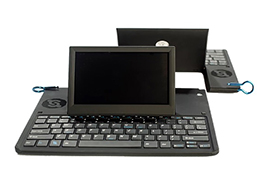On This Page
Introduction
According to the Merriam-Webster dictionary, technology is the use of science in industry, engineering, etc., to invent useful things or to solve problems. Assistive technology (AT) refers to technology that is specifically designed for and used by people with disabilities. The following steps are helpful when choosing AT to meet the specific accommodation needs of an employee with a disability:
Step 1. Define the Situation
The first step in choosing AT to accommodate an individual with a disability is to define the situation. An effective way to do this is to determine what job functions need to be accommodated by evaluating the individual’s work site, work station, and work activities. Answering the following questions will assist with defining the situation:
- What are the individual's functional limitations? A functional limitation involves difficulty in performing one or more specific work activities (e.g., difficulty communicating during meetings, using a telephone, reading print material, lifting boxes, and using a keyboard).
- What is the extent and type of impairment? Determining whether a condition is progressive or stable may not always be a factor to consider. However, knowing how the individual's condition will improve or worsen over time can be important when choosing AT (e.g., an employee with progressive vision loss may benefit from screen magnification now, but may need screen reading software in the future as his condition worsens. In some cases, it may make more sense to go ahead and purchase the screen reading software now).
- What job tasks are difficult to perform as a result of the impairment? This may be a good time to study the individual's job description to determine the essential and marginal functions of the position (e.g., distinguishing color, entering data, lifting materials, and tolerating stress).
Step 2. Explore Available AT Options
Once the situation has been defined, the next step is to explore available AT options. A good starting point is consulting with the individual who needs the accommodation. Often the individual knows what AT is available. Also, talking with the individual can help determine whether the individual is proficient in using a certain type of AT, which can save research and training time. Another way to explore available AT options is to contact JAN directly to speak with an AT specialist and/or access JAN’s Searchable Online Accommodation Resource (SOAR), which lets users explore various accommodation options for people with disabilities in work settings.
Other resources that can help employers explore available AT options include the following agencies:
- State Vocational Rehabilitation (VR) agencies provide services to ensure gainful employment for people with disabilities. In addition to job placement, services may include, but are not limited to counseling, vocational evaluation, assessment, on-the-job training, rehabilitation technology services, and possible assistance with funding accommodations.
- State AT Projects provide technical assistance on AT, consultation, product demonstrations, equipment borrowing, and low-interest loans for individuals with disabilities.
- The Rehabilitation Engineering and Assistive Technology Society of North America (RESNA) provides information on Assistive Technology Practitioners (ATP) or Rehabilitation Engineering Technologists (RET).
A final option for exploring available AT is to consult with the computer technician or IT team at the individual’s workplace. Compatibility and feasibility issues should be addressed and it may be possible for an IT representative to download trial versions and test free demos of AT.
Step 3. Choose AT
Once steps 1 and 2 are completed, an informed choice can be made about the AT. When choosing AT, consider the following:
- Is there technical support available?
- Is there a money back guarantee and warranty?
- Is there an option to upgrade with newer versions?
- Is the product compatible with other technology used?
- Is training available?
- Does the electronic infrastructure support interoperability with the AT?
- How will the AT be funded?
Tax incentives, vocational rehabilitation services, and local civic organizations may assist with funding AT. For more information on funding options, go to JAN's A to Z by Topic: Funding.
Step 4. Implement AT
Once a potential AT solution is chosen, the next step is to implement the AT, which involves purchasing the product or service, providing appropriate training, and ensuring that the individual with the disability can successfully use the AT.
Step 5. Monitor and Upgrade AT
Providing AT as an accommodation is an ongoing process between an employee and his/her employer. It is important to keep the lines of communication open, to monitor the effectiveness of the accommodation to ensure that the AT is meeting the needs of the employee and employer, and to upgrade the AT as needed. Some questions to consider include:
- If training was provided, was it effective?
- Is the AT being used properly?
- Is the AT being maintained?
- Should other accommodations besides AT be considered?
Take into account any changes in the individual's functional limitations or job duties that would alter current accommodation needs and the effectiveness of the AT. When changes occur, an employer may need to communicate with employees who use AT in the workplace.
Situations and Solutions:
The following situations and solutions are real-life examples of accommodations that were made by JAN customers. Because accommodations are made on a case-by-case basis, these examples may not be effective for every workplace but give you an idea about the types of accommodations that are possible.
JAN Publications & Articles regarding Assistive Technology (AT)
Publications
Consultants' Corner Articles
- Addressing Requests for Sit/Stand Workstations
- Best Practices for Addressing Requests for Ergonomic Chairs
- Communication Access Realtime Translation (CART) as a Work-Site Accommodation for Individuals who are Deaf or Hard of Hearing
- Life in a Cube: Problems Experienced by Employees with Cognitive Impairments
- Roy G. Biv Considers Color Deficiency
- Two-Way Radios as Accommodations
- Using Ergonomics to Accommodate Limitations from Breast Cancer
Articles
- Accommodating Deaf and Hard of Hearing Employees in Virtual Meetings
- Accommodating Employees with Hearing Aids: A Beginner's Guide to T-coils
- Assistive Technology Solutions for Employees with Speech Impairments
- Best Practices for Addressing Requests for Adjustable Height Workstations
- Determining if Apps Are Right for You
- Material Lifting Devices, Final Series Installment
- Material Lifting Devices, Part 1 of a Continuing Series
- Material Lifting Devices, Part 2 of a Continuing Series
- New Discovery for “Hands-Free” Phone Access
- Tech Tip: Converting a PowerPoint file to PDF
- Tech Tip: Don't Forget About Tab Order!
- When New Technologies Hurt
Blog Posts
- A JAN Interview with Marty Exline from the Association of Assistive Technology Act Programs (ATAP)
- Accommodating Cooks with Low Vision
- Common Questions about Providing Equipment as an Accommodation
- Don’t Break the Bank — Low Cost Accommodations Do Exist!
- Elevating Lift Office Chairs
- JAN Blog – Focus on Technology














